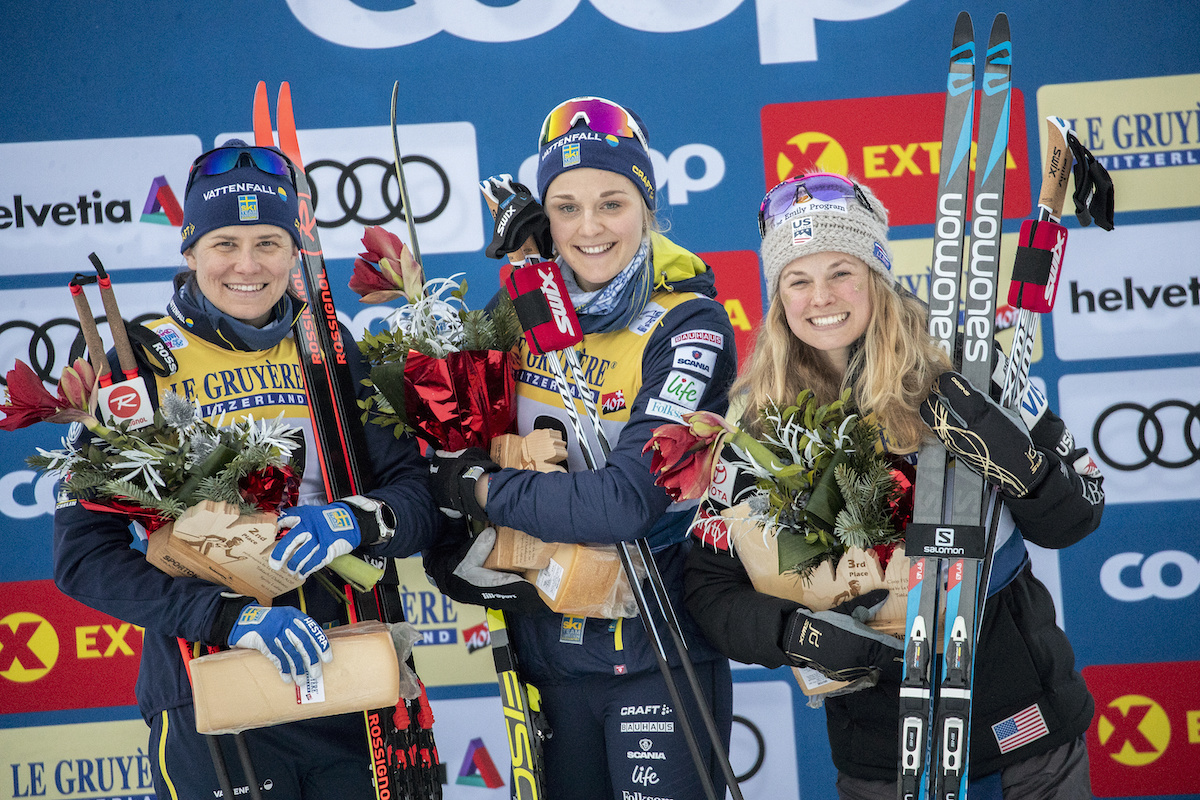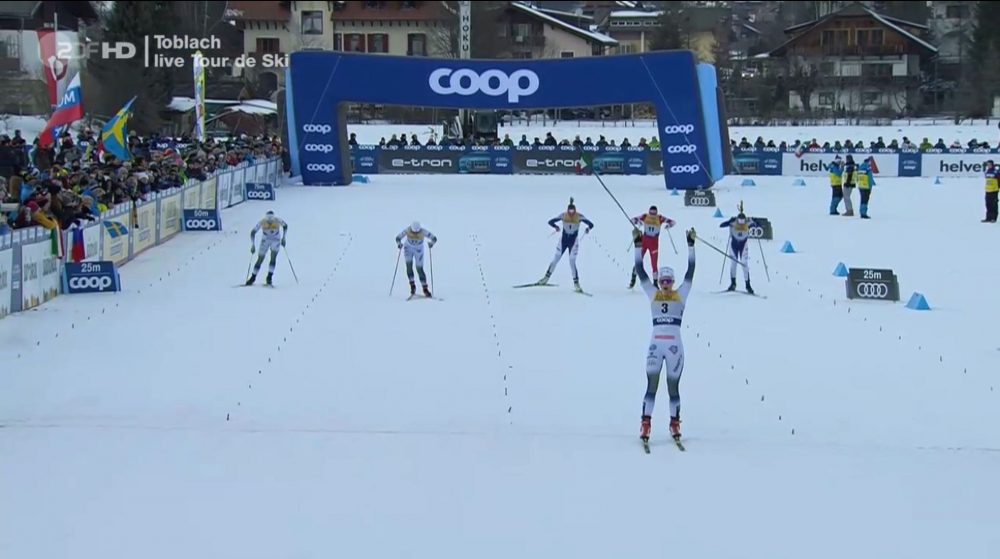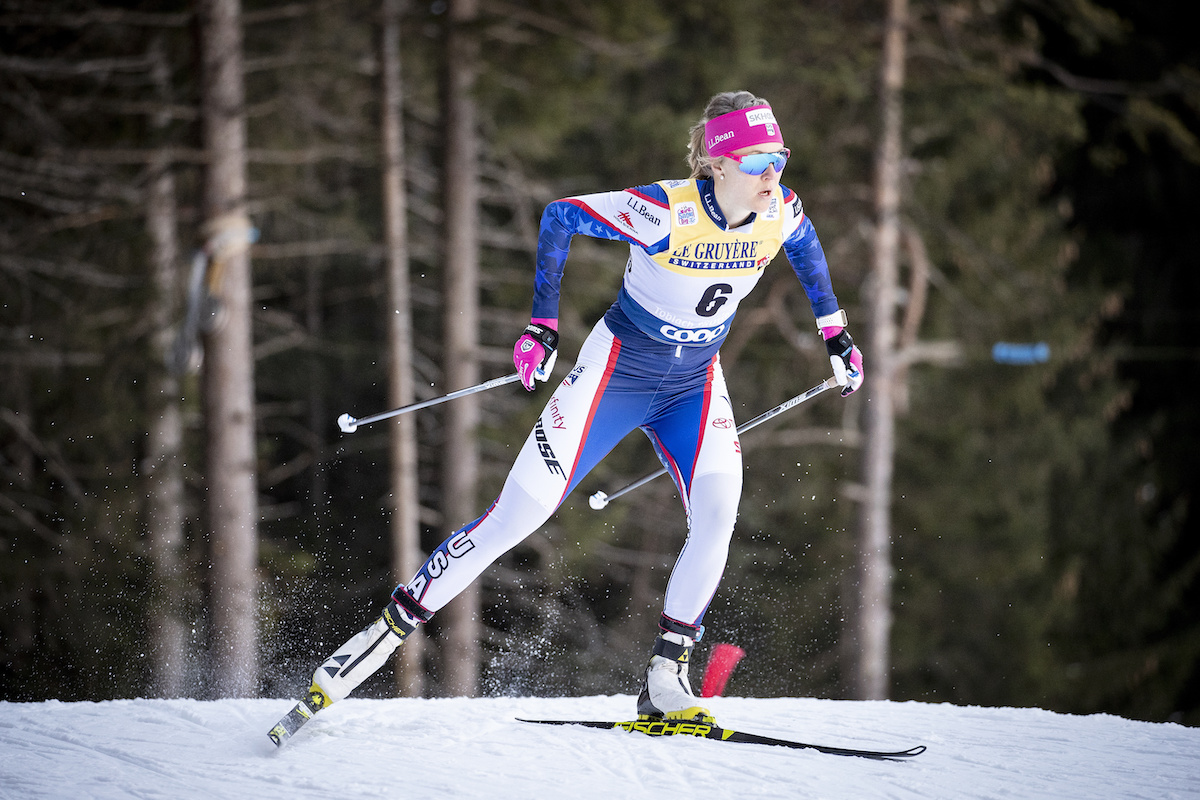
The threads of the thirty skiers who made the women’s heats of the 1.3-kilometer freestyle sprint during Stage 1 of the Tour de Ski (TdS) in Toblach, Italy on Saturday could weave a complex pattern. There are the lead changes. Skiers advanced. Skiers were eliminated. At the start of a seven-stage event, one race, and the first at that, simply established the early markings of a pattern. Nothing too complex to discern — but nascent trends with six stages to go.
Sweden’s Stina Nilsson smashed the women’s final winning by three seconds over second-place teammate Ida Ingemarsdotter. Jessie Diggins of the U.S. placed third (+3.07) for her first podium of the season.
Nilsson pulled away and skied off the front around two minutes into the race, while the remaining skiers fought for second through sixth. Russia’s Yulia Belorukova placed fourth (+3:16). Sweden’s Linn Soemskar fifth (+3.26), and Sadie Bjornsen of the U.S. – the fastest qualifier on the day — finished in sixth.
“It was a little bit like 100-meter racing where you just try to die less than the rest of the group, but everybody slows down,” U.S. Ski Team Coach Matt Whitcomb said in a phone call. “And Stina just died less and everybody else just died more. Standing on the side of that hill, from about 100 meters away, I could just see it happen pretty clearly. Stina was the only one who was able to keep her energy moving up that climb. It was really impressive.”
With her dominating performance in the final, after barely edging Diggins and Bjornsen in the first semi-final, Nilsson reiterated that she plans on pulling from the TdS after the fourth stage. Until then, Nilsson has a 10 k skate, another skate sprint, and a 10 k classic mass start to contest.
“I said before that I will only do the first 4 races, we will see but I think I will stick to that plan,” Nilsson told the International Ski Federation (FIS).
This much is clear after a single race: Nilsson and her teammates have come to the TdS in shape with Nilsson displaying both top end sprint speed and a combined high-speed endurance as displayed by her “died less” finals performance.
Three Swedes were in the finals. Whereas traditional powerhouse Norway placed two women in the top-twelve, none of whom advanced beyond the semis. Norway’s top qualifier was Maiken Caspersen Falla in 12th (+2.70).
One race defines nothing for Norway. As a single race defines little at best for any other team in the TdS. The women race over 60 k in seven stages. They ticked off 1.3 k today.
But again, the threads from a single race do begin the narrative. As for Nilsson, the language in her quote includes the phrase “we will see” when pushed on her intentions to abandon the TdS as planned. So “we will see” if, in fact, she remains high in the standings whether she indeed pulls from the competition.

The U.S was the only team to place three women in the top-10 during qualification. Bjornsen skied the 1.3 k course with the fastest qualifying time of 2:35.95 minutes. Diggins qualified in sixth (+1.38), Sophie Caldwell in ninth (+1.60).
“Today was a solid day for me,” Caldwell emailed. “But I definitely left wanting a bit more. It’s a tricky course that is pretty quick but has a fair amount of climbing and jostling for position. I felt like a skied my quarterfinal well and was able to move up throughout my heat and get myself into a good position by the top of the last climb.”
That position allowed her to keep position and win her quarterfinal.
Bjornsen, Diggins, and Caldwell all skied in the first semi. Caldwell was eventually eliminated as she placed fifth.
“Our semi was definitely loaded, but that’s how it goes sometimes,” Caldwell wrote. “The first semi gets the advantage of more rest before the final, so it tends to be slightly more stacked. I was happy with the move I made up the 2nd hill and had myself in a pretty good position going over the top of the last hill, but unless you’re in the lead, it’s really hard to control what’s going to happen on a course like that where everyone tends to come together on a tricky corner. My lane didn’t end up as open as I was hoping it would be, but it’s hard to say if the results would have been any different if it had been – it was a tight heat and everyone was skiing strong. My goal was to make the final, and I was disappointed to just miss it, but it was still a solid day and pretty awesome to have three girls in the top 10, Jessie on the podium, Kevin with a season-best, and Sim looking super strong even though he had a bit of bad luck.”

Bjornsen was third in the semi and advanced to the final as the first lucky loser. Diggins placed second, one-hundredth of second ahead of Bjornsen.
“I was definitely really excited to have such a strong qualifier today because I got super sick over Christmas time and spent three days with a fever and quite a bad cough so I was worried that I was going to even be able to start the Tour,” Bjornsen told FasterSkier in a call. “So it was definitely really encouraging to feel like I was back in form to start the qualifier, which kind of put me in with some confidence in my legs going forward.”
Bjornsen and Diggins lined up in the first heat together. Bjornsen skied on the sharp end for most of the heat’s duration. The two U.S. skiers came into the final straight nearly side by side and unchallenged at the front. Diggins slotted ahead of Bjornsen for the win by .24 seconds.
“I’ve done a ton of work on my starts and I’m finally in a place now where I can find myself in the front of the heat at the start which is nice because for me I just need to go hard over the entire course,” Bjornsen said of her strategy in the sprint heats. “I can’t just play those games, I just don’t have the strong finishing stretch of everybody. So it always benefits me to kind of ski in the front of the heat and kind of tire out those pure sprinters so that maybe I can break their legs when they come to the finishing stretch.”
Bjornsen scored her first career skate sprint podium in Lillehammer, Norway on Nov. 30. Her skate sprint consistency is now beginning to compliment her classic skiing power, speed, and endurance. Not that Bjornsen is in a learning phase of her career, but advancing well into the skate sprint heats has allowed Bjornsen to test her skate engine.
“I’m happy, I just haven’t skied a ton of semi-finals or finals in skate sprints,” Bjornsen said. “I had some success in Lillehammer, but aside from that, I haven’t done a ton of it. So for me, it’s always exciting to make it past the quarterfinals because then I know I’m in a position to play.”
Bjornsen did ultimately come up against a threshold today in the final. Her ski-in-front position took a slight toll as Nilsson took control of Bjornsen’s semi-final and final.
“I think in the semi-final I kind of exploded the remains of my speed in my legs and I was really happy to make it through as a lucky loser,” Bjornsen explained. “Starting the final I could feel right away that I was running on final fumes but just tried to position myself behind Stina. As she took off in those final climbs I was not able to go with her but just tried to remain in the front and hope that I had a good finishing stretch sprint.”
Bjornsen is firm that despite her standings after the fifth stage of the TdS, she will exit the Tour. During her interview, Bjornsen stated outright that finishing the TdS atop the Alpe Cermis — no matter her finishing place — on the final climb is arguably her favorite moment in racing the World Cup. In last season’s run up to the Olympics, Bjornsen raced the entire TdS.
Bjornsen’s macro-plan is to conserve energy and peak for the Seefeld, Austria’s World Championships.
“It’s been really hard for me to make that decision this year,” Bjornsen said about her premeditated Tour exit. “But that means I have never really focused or just channeled all my energy on the Championships. I tried last year during the Olympics but I don’t think that I was making the right decisions for my fatigue level. I think I was deciding to do the races that were fun all the time. So it’s definitely it’s hard for me to say not to finish the whole Tour because I like to think that I can just do everything. I also want to focus on the Championships and now that I’ve started feeling really great in skate sprint I think that there’s an awesome opportunity there.”

crossed the line before Diggins to place second. (Photo: ZDF screenshot)
Diggins’s racing left nothing to doubt. Through her qualifier to the end of the finals, Diggins was a presence. With her first podium of the season, she also admitted the difficulties finding joy in skiing during Period 1.
Diggins posted an earnest and transparent blog post on Friday about the issue. Here’s one quote:
“Ever since the Olympics, I have felt as though there’s been enormous outside pressure coming down on me. Maybe it’s the increased access to athletes that comes with much better broadcasting, social media, TV interviews, and online reporting. Maybe it’s my own naiveté, thinking that cross-country skiing would never have the same kind of press and pressure that comes with the “big sports”. Whatever the reason, this season it’s been incredibly hard for me to tune out the external pressure to (simply) “be amazing” all the time.”
In reality, Diggins’s performance in Period 1 was in stride with her past. Yes, Saturday was her first podium of the season. Diggins also placed fifth in her last race – a grueling 10 k skate in Davos, Switzerland. Needless to say, the world of sport comes with pressure. Now for Diggins, pressure well beyond the scope of the cross-country world. Overtly, Diggins remains on track. And she stated outright on the phone Saturday that she skied with a smile in Toblach.
“I am having fun,” Diggins said. “And it happened to come with a podium. But I think it’s important to say that the most important thing for me was that it was fun. Because if you podium and you are not loving what you are doing, then it doesn’t matter.”
Pressure is nothing new to Diggins. Since high school, she has been dealing with mounting pressure and expectations. Back then it was not if Diggins would win but by how much. And if she didn’t meet some external time benchmark between herself and the next best skier back, then maybe it wasn’t good enough. And there was even pressure to beat most of the male athletes at a given race.
In Toblach, Diggins may have been tempered out of the start gates, building into her quarter, semi, and finals. But she found gaps. She made her own moves. She matched moves. She skied in the moment on her way to third place overall. The big prize six more stages away atop the Alpe Cermis in Val di Fiemme, Italy.
And there was Saturday’s podium shot. That is a smile.
Racing continues tomorrow with a 10 k skate for the women.
Jason Albert
Jason lives in Bend, Ore., and can often be seen chasing his two boys around town. He’s a self-proclaimed audio geek. That all started back in the early 1990s when he convinced a naive public radio editor he should report a story from Alaska’s, Ruth Gorge. Now, Jason’s common companion is his field-recording gear.



